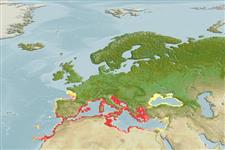>
Eupercaria/misc (Various families in series Eupercaria) >
Sparidae (Porgies)
Etymology: Diplodus: Greek, diploos = twice + Greek, odous = teeth (Ref. 45335).
More on author: Linnaeus.
Environment: milieu / climate zone / depth range / distribution range
Ecologia
marinhas; estuarina bentopelágico; intervalo de profundidade 0 - 90 m (Ref. 4781). Subtropical; 49°N - 27°N, 19°W - 42°E
Eastern Atlantic: Canary islands, also found along the coast of Portugal northward to the Bay of Biscay, Mediterranean, Black Sea and Sea of Azov (Ref. 4781).
Length at first maturity / Tamanho / Peso / Idade
Maturity: Lm 11.6, range 8 - 19.6 cm
Max length : 28.0 cm TL macho/indeterminado; (Ref. 124816); common length : 13.0 cm TL macho/indeterminado; (Ref. 3397); peso máx. Publicado: 330.00 g (Ref. 115876); Idade máx. registada: 17 anos (Ref. 124518)
Descrição breve
Chaves de identificação | Morfologia | Morfometria
Espinhos dorsais (total) : 11; Raios dorsais moles (total) : 11 - 13; Espinhos anais: 3; Raios anais moles: 11 - 12.
Inhabit chiefly Zostera seagrass beds but also found on Posidonia beds and sandy bottoms, rarely on rocky bottoms. Carnivorous, feed on worms, crustaceans, mollusks, echinoderms and hydrozoans. The sexes are separated, although these fish are potential hermaphrodites; certain individuals are protandric (Ref. 4781).
Normally sexes are separate but some individuals are protandrous due to geographical variation in sexual pattern (Ref. 103751). However, histological studies confirm no degenerating functional tissue of one sex (e.g. vitellogenic or later-stage follicles) and no proliferation of tissue of the other sex can be found on this species indicating the absence of sex change. This particular condition is also known as nonfunctional hermaphroditism previously known as rudimentary hermaphroditism (Ref. 91314). Also Ref. 28504.
Bauchot, M.-L. and J.-C. Hureau, 1990. Sparidae. p. 790-812. In J.C. Quero, J.C. Hureau, C. Karrer, A. Post and L. Saldanha (eds.) Check-list of the fishes of the eastern tropical Atlantic (CLOFETA). JNICT, Lisbon; SEI, Paris; and UNESCO, Paris. Vol. 2. (Ref. 3688)
Categoria na Lista Vermelha da IUCN (Ref. 130435)
Ameaça para o homem
Harmless
Utilização humana
Pescarias: espécies comerciais; peixe desportivo: sim
Ferramentas
Relatórios especiais
Descarregue XML
Fontes da internet
Estimates based on models
Preferred temperature (Ref.
123201): 14.8 - 21.1, mean 18.3 °C (based on 220 cells).
Phylogenetic diversity index (Ref.
82804): PD
50 = 0.5000 [Uniqueness, from 0.5 = low to 2.0 = high].
Bayesian length-weight: a=0.01202 (0.01093 - 0.01323), b=3.07 (3.05 - 3.09), in cm total length, based on LWR estimates for this species (Ref.
93245).
Nível Trófico (Ref.
69278): 3.6 ±0.0 se; based on diet studies.
Generation time: 4.5 (2.4 - 6.4) years. Estimated as median ln(3)/K based on 18
growth studies.
Resiliência (Ref.
120179): Médio, tempo mínimo de duplicação da população 1,4 - 4,4 anos (K=0.2-0.5; tmax=7; Fecundity=18,000 - 212,000).
Prior r = 0.54, 95% CL = 0.35 - 0.80, Based on 3 full stock assessments.
Fishing Vulnerability (Ref.
59153): Moderate vulnerability (36 of 100).
Climate Vulnerability (Ref.
125649): Moderate vulnerability (36 of 100).
Nutrients (Ref.
124155): Calcium = 83.2 [48.2, 160.3] mg/100g; Iron = 0.984 [0.561, 1.738] mg/100g; Protein = 19.3 [18.4, 20.3] %; Omega3 = 0.427 [0.224, 0.818] g/100g; Selenium = 23.7 [11.6, 43.4] μg/100g; VitaminA = 20.1 [6.8, 55.9] μg/100g; Zinc = 1.06 [0.72, 1.48] mg/100g (wet weight);
